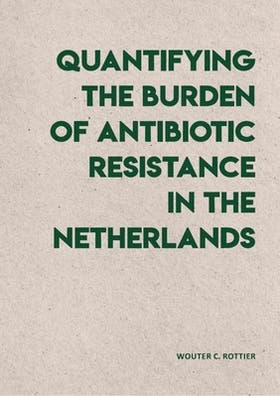Wouter Rottier
Quantifying the Burden of Antibiotic Resistance in the Netherlands

- Datum
- (Co) promotoren
- 19-02-2019
- prof.dr. M.J.M. Bonten, dr. H.S.M. Ammerlaan
Samenvatting
In the Netherlands, the issue of antibiotic resistance in case of infections in the hospital mainly concerns extended-spectrum β-lactamase (ESBL) producing Enterobacterales and vancomycin-resistant Enterococcus faecium (VRE). The aims of this thesis were (i) to establish the attributable mortality of ESBL-producing Gram-negatives and VRE in case of infection, and (ii) to investigate the options for predicting the presence of ESBL-producing Gram-negatives when a patient presents with infection. The thesis begins with a meta-analysis (from 2010) of 32 studies comparing mortality between bacteremia with ESBL-producing and non-ESBL-producing Enterobacterales. The pooled unadjusted odds ratio (OR) for mortality associated with ESBL production was 2.35 (95% confidence interval (CI) 1.90–2.91). In the 15 studies that corrected for confounding factors, the adjusted OR was 1.52 (95% CI 1.15–2.01). Among these studies, those that erroneously adjusted for the intermediate variables inappropriate empiric therapy and sepsis severity, reported lower adjusted ORs. Subsequently, non-experimental clinical studies evaluated how well these findings generalize to the Netherlands. In 12% of 1,954 Gram-negative infections occurring between 2013 and 2016 in eight Dutch hospitals, resistant Gram-negatives (mostly ESBL-producing Enterobacterales) were the cause. After adjustment for confounding factors, no increase in 30-day mortality was apparent in case of antibiotic resistance (risk ratio (RR) 1.05, 95% CI 0.46–2.35). A possible explanation is that inappropriate empiric antibiotic therapy, the most likely intermediate on the causal pathway leading from antibiotic resistance to mortality, was not associated with increased mortality. A similar study was performed to establish the attributable mortality of vancomycin resistance in E. faecium bacteremia. In 16 Dutch and 4 Danish hospitals between 2009 and 2014, 63 VRE bacteremias were compared to 234 ampicillin-resistant E. faecium (ARE) bacteremias. The adjusted RR for 30-day mortality for VRE was 1.54 (95% CI 1.06–2.25). Delayed appropriate antibiotic therapy did not appear to be the reason for this observed higher mortality. One explanation for the effect is unmeasured confounding. Alternatively, increased virulence in VRE may be the cause, although both ARE and VRE belong to the same well-characterized genomic lineage. For the second aim of this thesis, it was investigated how well the presence of ESBL bacteremia can be anticipated by the stratification scheme in the Dutch sepsis guidelines, which relies on prior ESBL-positive cultures, and recent use of cephalosporins and/or fluoroquinolones. In a sepsis cohort in two Dutch hospitals, the prior probability of ESBL bacteremia was only 0.7%. The stratification scheme had a sensitivity of 50% for this outcome, but classified 19% of all sepsis episodes as at risk of ESBL infection. Therefore, diagnostic scoring systems for better prediction of ESBL bacteremia in sepsis were developed with data from eight Dutch hospitals. By incorporating several additional predictors, the proportion of patients classified as at risk for ESBL bacteremia could be reduced by 40% (95% CI 21–56%) and 49% (95% CI 39–58%), in respectively community-onset and hospital-onset sepsis. After external validation, these scoring systems may be used to better balance inappropriate empiric antibiotics and unnecessary carbapenem use in the treatment of sepsis.
